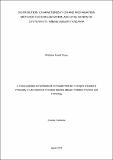Distribution, characterization and propagation methods for conservation and utilization of oyster nuts telfairia pedata in Tanzania
Abstract
Oyster nut (Telfairia pedata) is a native East African climber, growing naturally or planted
in association with tall trees Tanzania (including Zanzibar island), Kenya and Uganda. Plot less sampling method within different land use (farmlands, homesteads, and along
riverbanks) was used to understand the spatial distribution of oyster nuts across elevation and
rainfall gradients and a cross-sectional survey using semi-structured questionnaire was
conducted on 346 respondents to assess the utilization and conservation status of oyster nuts
in northern Tanzania. In addition, phylogenetic analysis were used to assess the genetic
variability of oyster nuts collected from the study location and lastly developing local
propagation methods for the production of oyster nut seedlings for farmers in northern
Tanzania. The findings on the spatial distribution of oyster nuts indicated that more oyster nut
plants grow in higher elevations and areas with higher rainfall. The findings on utilization
and conservation status of the oyster nuts reveal that about 21% of respondents used oyster
nuts for cooking with other staple foods while (18%) claimed that the nuts are used by
pregnant and lactating mothers for medicinal and breast milk stimulation and nine percent
indicated that the nuts are used for ritual and cultural devotions. Also, respondents within the
36-50 age groups reported the greatest diversity of uses of oyster nuts were (51%) compared
with those aged below 36 years old (21%). The findings on genetic analysis suggest that the
oyster nut (Telfairia pedata) is the only specie that exists in Tanzania with similarity of >99%
to known accessions as deposited in the National Center for Biotechnology Information
(NCBI). Although the accessions were obtained from different districts in Northern Tanzania,
their close genetic similarity indicates that they might have originated from the same parents
and were introduced to other sites through cultivation by human interventions. The findings
on propagation methods for the production of oyster nut seedlings indicate that mother plant
topsoil and Nitrogen, Phosphorus and Potassium fertilizer levels and mother plant topsoil and
cow manure are the best media for the propagation of oyster nuts using stem cuttings. The
study concludes that oyster nuts offers multiple benefits to farmers and is the only species
that exist in Tanzania. The study recommends: (i) Promote the multipurpose and only oyster
nut plant that exist in Tanzania through workshops and seminars to contribute to food
security and biodiversity conservation; (ii) mother plant topsoil and NPK or cow manure are
the most suitable soil mixture for raising oyster nuts from stem cuttings; and (iii) Research
institutions can take an interest in both in-situ and ex-situ long-term monitoring trends of
oyster nuts (Telfairia pedata) distribution as it is the only specie that exists in the country.

